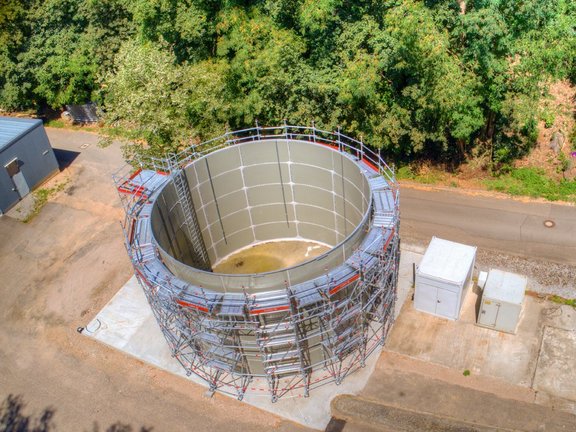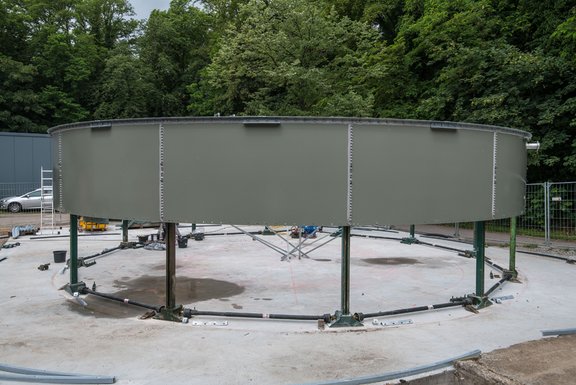Recently, a large tank has been installed on the MPIK premises between the experimental halls and the storage building. What is this “body-of-water simulation tank”? It is related to the planned gamma-ray observatory SWGO (Southern Wide-field Gamma-ray Observatory), which is foreseen for astronomical observations high up in the Andes, at the highest energies, with a wide field-of view, and around the clock. As a southern counterpart to HAWC in Mexico (and LHAASO in China), it will directly detect the shower particles emerging from highly energetic gamma rays hitting the atmosphere. The detection is done by measuring the light produced by the shower particles in water.
SWGO will be considerably larger and more sensitive than HAWC, which consists of an array of 300 close-packed large water tanks surrounded by 350 loosely packed smaller tanks. As an additional improvement, the water volume may be divided in to two layers, to be able to better distinguish between gamma rays and charged particles of the cosmic radiation. Furthermore, the inner array of SWGO will be more densely packed and more finely segmented than that of HAWC, providing a more detailed view of the particle shower and hence improving the determination of the gamma ray’s energy and direction of origin. The envisaged core area of 80000 m2 will require about 5000 detection units, and another 1000 or so are needed for the outer array. As well as individual tanks as in HAWC, SWGO is considering to build huge ‘swimming pools’ divided by curtains and covered with a roof, as used in LHAASO.
Can such an engineering feat be realised in a remote region at an altitude of more than 4400 metres? Large tanks and also the alternatives need solid foundations and stable walls to withstand the water pressure; if there is no sufficient water reservoir nearby, it must be transported to the experimental site by tankers – all possible, but expensive.
An elegant path – is it viable?
Using a natural lake would therefore be an attractive option: its water could be purified on-site and then be used to fill sealed bladders as detector units floating in the lake. Such bladders wouldn’t have to withstand any pressure, so they could be made of thin material. But they shouldn’t deform too much due to waves. Furthermore, they must be light-tight and perhaps white or reflective on the inside to allow the light sensor inside the bladder to capture as much of the Cherenkov light produced by passing shower particles as possible.
The MPIK simulation tank with its diameter of 11 m and height of 6 m will help us to find out whether, and if so how, this concept can be made to work in practice. It simulates a lake containing about 550 tonnes of water; the scaffolding around it provides the experimentalists with access to the open top to submerge test versions of the bladders into the tank. “We will test several bladder materials with and without stiffening, both in view of their stability and their optical properties. We will also equip the balloons with light sensors – photomultiplier tubes from the former Double Chooz neutrino experiment,” explains Felix Werner, staff scientist in the division of Jim Hinton. The high-voltage supply and read-out electronics are placed in a container next to the tank. A second container houses a water circulation and filter system which can gently agitate the “lake”.
Markus Klaiber, head of the technical building services, provides details of the construction process: “The tank consists of steel plates, which were screwed and sealed ring by ring from top to bottom; a lifting apparatus applied in the interior lifted the construction after completion of each ring. Thus, a crane was not required and the technicians did not need to climb onto a scaffold.”
„Should our experiments in the simulation tank be successful, in a next step we will have to find out how thousands of such detection units can be installed in a real lake and operated as a scientific instrument – a challenge that shouldn’t be underestimated,” says Jim Hinton, also spokesperson of the SWGO collaboration, looking to the future. The development phase of SWGO is intended to be finalised by the end of 2022, with the observatory site and the approach to the construction and deployment of the detection units firmly established.

